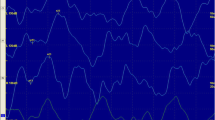Abstract
Purpose
The aim of the present study is to establish if the vestibular evoked myogenic potentials (VEMPs) could be used as a clinical test for the evaluation of vestibular function in children affected by myelomeningocele (MMC).
Materials and methods
Fifteen children, aged between 3 and 17 years, who had been affected by MMC were investigated. Data obtained from these children were compared with normal data from healthy children of the same age. Electromyographic activity of sternocleidomastoid muscle was recorded, while children were laid supine and asked to raise their head off the bed in order to activate their neck flexors bilaterally. The saccular receptors were acoustically stimulated with a logon of 500 Hz at an intensity of 130 dB peSPL presented monaurally through earphones. In each recording, we analyzed latencies and amplitudes of the p13-and n23 waves and the amplitude ratio between the two ears.
Results
VEMPs were detected to be normal in 13 patients. In particular, the mean p13 and mean n23 latencies were 15.7 (±1.4) and 21.7 (±1.1) ms, respectively; the mean amplitude value was 84.7 (±36.6), while the mean amplitude ratio was 17.4 (±12). A comparison of latencies and amplitude ratios between the children and healthy control group did not reveal any significant difference. On the contrary, a comparison of amplitude values between the two groups showed significant differences.
Conclusion
In conclusion, vestibulocollic reflex is normal in patients affected by MMC, and VEMPs could represent a valid and noninvasive technique eligible to investigate the vestibular functions in these children.
Similar content being viewed by others
References
Botto L, Moore CA, Khoury MJ, Erickson JD (1999) Neural tube defects. N Engl J Med 341:1509–1519
Colebatch JG, Halmagyi GM (1992) Vestibular evoked potentials in human neck muscles before and after unilateral vestibular deafferentation. Neurology 42:1635–1636
De Bleecker JL (2005) How to approach the patient with muscular symptoms in the general neurological practice? Acta Neurol Belg 105(1):18–22
Galli M, Albertini G, Romei M, Santambrogio GC, Tenore N, Crivellini M (2002) Gait analysis in children affected by myelomeningocele: comparison of the various levels of lesion. Funct Neurol 17(4):203–210
Gutierrez EM, Bartonek A, Haglund-Akerlind Y, Saraste H (2005) Kinetics of compensatory gait in persons with myelomeningocele. Gait Posture 21(1):12–23
Jafari Z, Asad Malayeri S (2011) The effect of saccular function on static balance ability of profound hearing-impaired children. Int J Pediatr Otorhinolaryngol 75(7):919–924
Jin Y, Shinjo Y, Akamatsu Y, Yamasoba T, Kaga K (2009) Vestibular evoked myogenic potentials of children with inner ear malformations before and after cochlear implantation. Acta Otolaryngol 129(11):1198–1205
Kelsch TA, Schaefer LA, Esquivel CR (2006) Vestibular evoked myogenic potentials in young children: test parameters and normative data. Laryngoscope 116:895–900
Lee GS, Zhou G, Poe D, Kenna M, Amin M, Ohlms L, Gopen Q (2011) Clinical experience in diagnosis and management of superior semicircular canal dehiscence in children. Laryngoscope 121(10):2256–2261
Lennerstrand G, Gallo JE (1990) Neuro-ophthalmological evaluation of patients with myelomeningocele and Chiari malformations. Dev Med Child Neurol 32(5):415–422
Lin KY, Hsu YS, Young YH (2010) Brainstem lesion in benign paroxysmal vertigo children: evaluated by a combined ocular and cervical vestibular-evoked myogenic potential test. Int J Pediatr Otorhinolaryngol 74(5):523–527
Murofushi T, Curthoys IS, Topple AN, Colebatch JG, Halmagyi GM (1995) Responses of guinea pig primary vestibular neurons to clicks. Exp Brain Res 103:174–178
Picciotti PM, Fiorita A, Di Nardo W, Quaranta N, Paludetti G, Maurizi M (2005) VEMPs and dynamic posturography after intratympanic gentamycin in Menière’s disease. J Vestib Res 15(3):161–168
Picciotti PM, Fiorita A, Di Nardo W, Calò L, Scarano E, Paludetti G (2007) Vestibular evoked myogenic potentials in children. Int J Pediatr Otorhinolaryngol 71(1):29–33
Rendeli C, Ausili E, Tabacco F, Caliandro P, Aprile I, Tonali P, Salvaggio E, Padua L (2005) Assessment of health status in children with spina bifida. Spinal Cord 43(4):230–235
Rosengren SM, Welgampola MS, Colebatch JG (2010) Vestibular evoked myogenic potentials: past, present and future. Clin Neurophysiol 121(5):636–651
Shall MS (2009) The importance of saccular function to motor development in children with hearing impairments. Int J Otolaryngol 97:25–65
Sheykholeslami K, Megerian CA, Arnold JE, Kaga K (2005) Vestibular-evoked myogenic potentials in infancy and early childhood. Laryngoscope 115:1440–1444
Tubbs RS, Soleau S, Custis J, Wellons JC, Blount JP, Oakes WJ (2004) Degree of tectal beaking correlates to the presence of nystagmus in children with Chiari II malformation. Childs Nerv Syst 20(7):459–461
Valente LM (2011) Assessment techniques for vestibular evaluation in pediatric patients. Otolaryngol Clin North Am 44(2):273–290
Zhou G, Gopen Q (2011) Characteristics of vestibular evoked myogenic potentials in children with enlarged vestibular aqueduct. Laryngoscope 121(1):220–225
Author information
Authors and Affiliations
Corresponding author
Rights and permissions
About this article
Cite this article
Picciotti, P.M., Fiorita, A., Calò, L. et al. Vestibular evoked myogenic potentials in children affected by myelomeningocele. Childs Nerv Syst 28, 1761–1765 (2012). https://doi.org/10.1007/s00381-012-1779-8
Received:
Accepted:
Published:
Issue Date:
DOI: https://doi.org/10.1007/s00381-012-1779-8



